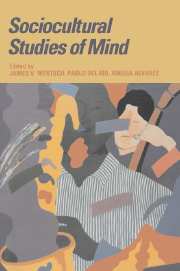Book contents
- Frontmatter
- Contents
- Series Foreword
- List of contributors
- Sociocultural studies: history, action, and mediation
- Part I Human action: historical and theoretical foundations
- Part II Mediation in action
- Part III Sociocultural setting, intersubjectivity, and the formation of the individual
- 6 Observing sociocultural activity on three planes: participatory appropriation, guided participation, and apprenticeship
- 7 The constitution of the subject: a persistent question
- Part IV Sociocultural settings: design and intervention
- Index
7 - The constitution of the subject: a persistent question
Published online by Cambridge University Press: 05 June 2012
- Frontmatter
- Contents
- Series Foreword
- List of contributors
- Sociocultural studies: history, action, and mediation
- Part I Human action: historical and theoretical foundations
- Part II Mediation in action
- Part III Sociocultural setting, intersubjectivity, and the formation of the individual
- 6 Observing sociocultural activity on three planes: participatory appropriation, guided participation, and apprenticeship
- 7 The constitution of the subject: a persistent question
- Part IV Sociocultural settings: design and intervention
- Index
Summary
One of the persistent questions debated within developmental, social, and cognitive psychology concerns the formation of individual consciousness or the constitution of the individual subject. The purpose of this chapter is to contribute to the discussion of this issue, reviewing selected topics and arguments raised by authors representative of the historical-cultural approach. In looking at a number of current tendencies and past contributions, we debate some of the conceptual aspects that concern us in relation to empirical investigative work and that seem to have relevant consequences at the theoretical-methodological level.
Although the role of social reality in the formation of the individual subject is a widely accepted (and obvious) idea, controversies and ambiguities arise when the nature of this role and the genesis of the individual processes are conceptualized. The approaches to this problem involve theoretical elaborations that tend to privilege either intra- or interindividual functioning. In the first case, we conceptualize individual functioning according to sociogenetic principles; in the second, we find contributions in studies relying on the concept of intersubjectivity. We will initially focus on these two tendencies.
Sociogenesis and individual processes
Within the discussions of sociogenetic approaches, we highlight the contributions of Valsiner (1987, 1994) in his attempts to develop a consistent explanatory model for understanding the formation of the individual.
In examining interpretations of the relationships between the individual and social reality, Valsiner (1992) points to three models of sociogenesis, which are based on the notions of harmonious learning, fusion, and contagion.
- Type
- Chapter
- Information
- Sociocultural Studies of Mind , pp. 165 - 184Publisher: Cambridge University PressPrint publication year: 1995
- 30
- Cited by

